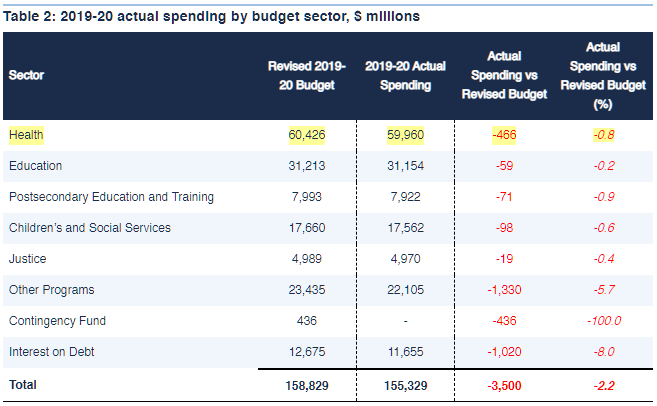In the 2019/20 Ontario budget health care was budgeted at $59.97 billion. That was subsequently increased by over $450 million to $60.42 billion, mostly through Supplementary Estimates late in the fiscal year.
The Financial Accountability Office (FAO) now reports (based on current, but not yet final figures) that actual health care spending was $59.96 billion – in other words, $466 million less than the revised health care budget. So, despite increasing the health care budget by $453 million late in the fiscal year, the government spent $13 million less than it first budgeted. That is about a 0.8% reduction compared with the revised budget plan.
It's a little hard to take Ford's protestations that he has no money for pandemic pay, and won't pay for more time to care, when he spends $466 million less on health care than he budgeted.
One area with lower than projected expenditures was the line item for local health agencies. This is odd as public health is rather important for the response to a pandemic -- like, say, COVID-19. Odder still, the government actually increased the local health agency budgets by $40.7 million during the course of the fiscal year. But the government actually spent $45.3 million less than the revised budget -- in fact $4.6 million less than the original budget.
Why would a government under-spend its own public health budget in the first 3 months of a major infectious disease outbreak?
A second area that got less than budgeted was "LHIN" funding. LHIN funding is actually mostly money for hospitals, long-term care, home care and some other health care providers. Here the government spent $91 million less than they planned in the 2019/20 budget. That is 0.3% less than budgeted. Unfortunately, it is not made clear how this affected each of the sub-sectors funded by the LHINs -- hospitals, LTC, home care -- or, for that matter, the LHIN organizations themselves.
Hospital infrastructure projects also came up short -- $299 million short of the original budget, or 20% less than budgeted. The FAO had already noted lower than projected spending for hospital infrastructure in its earlier 3rd quarter report, so low hospital infrastructure spending probably was expected by the government. Part of this under-spending may simply be a timing of payment issue, so it may be wrong to make too much of this -- yet.
Looking at the finer details, the docs got $82 million more than the original budget plan (no surprise), e-Health was down $42 million (about 17%), and e-Health capital spending was also down -- about 39% from its original budget.
Despite COVID-19, the overall 2019/20 deficit is lower than the government projected in the early spring of 2020. The deficit is now projected by the FAO at $8.7 billion, half a billion down from the $9.2 billion the government had projected. Governments, especially conservative ones, often over-estimate deficits.
The current $8.7 billion FAO estimate, however, is $2.6 billion more than the FAO prediction in early March 2020, just before the COVID-19 lockdown. The FAO estimate was more reasonable than the government's early spring estimate - -but then COVID-19 hit hard.
Key to the deficit being higher than the FAO expected was that 2019/20 revenues were down $2 billion over what was projected by the government in March 2020. The FAO puts that fall down to COVID-19, no doubt with some reason.
Nevertheless, this is a pretty big contraction given two factors. [1] The government made its estimate for 2019/20 revenue near the very end of the fiscal year and just as COVID-19 was about to hit Ontario hard. [2] The lock-down and its impact on the economy only began in mid-March, just about three weeks before the fiscal year ended. So the $2 billion hit to revenue appears to have occurred over a very short period of time.
Overall expenditures were down $2.3 billion compared to the government’s March 2020 estimate, primarily coming out of health, post secondary education and training, children's and social services, and (thanks to falling interest rates) interest on debt (again, there could not have been much surprise for government in that).
The $2.3 billion shortfall in expenditures is no surprise: it is part of a long tradition of under-spending budgets and is roughly in line with the FAO's estimate in March.
Here’s the link to the full FAO report: https://www.fao-on.org/en/Blog/Publications/2019-20-expenditure-monitor-q4

Comments
Post a Comment